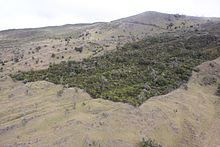20:
92:
In 2012, native cover increased from 3 percent to 82 percent by 2012 within the project area. 14 of 22 native tree species and six of seven native shrub species had successfully reproduced in restoration plots. 99% were native
80:
In June 2003, the
Leeward Haleakala Watershed Restoration Partnership was formed and supported the project. The partnership brought eight large landowners (holding 43,715 acres) together to better manage the
47:
Pre-contact dryland forest ecosystems were reduced to less than five percent of their original range by clearing, grazing and invasive species in the late 1800s. The wood went to fuel the boilers at
371:
110:. Stem counts had increased from 12.4 to 135.0/100 m2, and native species diversity increased from 2.4 to 6.6/100 m2. Reproducing species included two types of
221:
are planted to prevent invasives from reclaiming the area. After the 'a'ali'i have grown to height of six or more feet, other native tree sapling are planted.
310:
Medeiros, A. C.; Allmen, E. I. von; Chimera, C. G. (2014-01-01). "Dry Forest
Restoration and Unassisted Native Tree Seedling Recruitment at Auwahi, Maui".
67:
285:
224:
The project organizes monthly site visits carrying 20 to 30 volunteers. Volunteers plant saplings, gather seeds and pull weeds.
71:
96:
56:
366:
142:
More than 50 native species are found in the Auwahi region, including six endangered and five of concern.
127:
100:
119:
106:
147:
327:
131:
319:
218:
82:
66:
Restoration was initiated in 1997 by fencing a 10-acre area of
Ulupalakua Ranch, using
48:
19:
360:
197:
39:. The mostly volunteer-based restoration focuses on the 4,000-foot elevation range.
180:
60:
192:
hosting native birds that once populated that region, but migrated to the rainy
213:
are removed to prevent them from eating saplings and destroying habitat. Next,
111:
331:
214:
210:
86:
74:
32:
193:
115:
52:
173:
252:
123:
323:
18:
36:
31:
has produced a substantial forest on the southwestern slopes of
151:, a vascular wilt fungus that is fatal to trees of all sizes.
55:. By the early 1900s, the land was almost totally bereft of
286:"15-year effort brings native plants back to Auwahi forest"
209:
Reforestation areas are fenced, and feral pigs, goats and
349:
179:
linking
Hawaiian culture and crafts with a sustainable
217:is applied to remove invasive plant species. Then
63:was imported in the 1940s and became pervasive.
8:
372:Environmental organizations based in Hawaii
186:providing jobs to support rural lifestyles,
16:Forest restoration project on Maui, Hawaii
29:Auwahi Dryland Forest Restoration Project
232:
145:Native tree species are susceptible to
7:
280:
278:
276:
274:
272:
246:
244:
242:
240:
238:
236:
163:supporting native species diversity,
166:establishing a biological preserve,
14:
196:forests to face mosquito-borne
130:(also the word for iron in the
72:United States Geological Survey
169:enhancing watershed resources,
68:U.S. Fish and Wildlife Service
1:
70:funds. It was led by retired
85:on Haleakala's southwestern
251:PARSONS, ROB (2007-04-12).
388:
99:, Chamaesyce celastoides,
97:Osteomeles anthyllidifolia
189:economic diversification
24:
101:Nestegis sandwicensis
23:Auwahi Dryland Forest
22:
95:, Coprosma foliosa,
107:Bocconia frutescens
292:. February 2, 2015
148:Fusarium oxysporum
25:
132:Hawaiian language
35:on the island of
379:
353:
352:
350:Official website
336:
335:
307:
301:
300:
298:
297:
290:www.mauinews.com
282:
267:
266:
264:
263:
248:
134:) were present.
387:
386:
382:
381:
380:
378:
377:
376:
357:
356:
348:
347:
344:
339:
312:Pacific Science
309:
308:
304:
295:
293:
284:
283:
270:
261:
259:
250:
249:
234:
230:
207:
172:recharging the
159:Goals include:
157:
140:
59:and koa trees.
49:sugarcane mills
45:
17:
12:
11:
5:
385:
383:
375:
374:
369:
359:
358:
355:
354:
343:
342:External links
340:
338:
337:
324:10.2984/68.1.3
302:
268:
231:
229:
226:
206:
203:
202:
201:
190:
187:
184:
177:
170:
167:
164:
156:
153:
139:
136:
104:and nonnative
77:Art Medeiros.
44:
41:
15:
13:
10:
9:
6:
4:
3:
2:
384:
373:
370:
368:
367:Reforestation
365:
364:
362:
351:
346:
345:
341:
333:
329:
325:
321:
317:
313:
306:
303:
291:
287:
281:
279:
277:
275:
273:
269:
258:
254:
247:
245:
243:
241:
239:
237:
233:
227:
225:
222:
220:
216:
212:
204:
199:
198:avian malaria
195:
191:
188:
185:
182:
178:
175:
171:
168:
165:
162:
161:
160:
154:
152:
150:
149:
143:
137:
135:
133:
129:
125:
121:
117:
113:
109:
108:
103:
102:
98:
90:
88:
84:
78:
76:
73:
69:
64:
62:
58:
54:
50:
42:
40:
38:
34:
30:
21:
318:(1): 33–45.
315:
311:
305:
294:. Retrieved
289:
260:. Retrieved
256:
223:
208:
181:silviculture
158:
146:
144:
141:
105:
94:
91:
79:
65:
61:Kikuyu grass
51:and to make
46:
28:
26:
361:Categories
296:2018-02-14
262:2018-02-13
253:"Maui Koa"
228:References
120:iliahialoe
112:sandalwood
332:0030-8870
257:Maui Time
215:herbicide
211:axis deer
183:industry,
87:rift zone
83:watershed
75:biologist
33:Haleakala
219:'a'ali'i
194:windward
53:charcoal
205:Process
174:aquifer
138:Habitat
43:History
330:
124:Mauila
116:iliahi
93:'o'hia
57:`ohi`a
155:Goals
328:ISSN
126:and
118:and
37:Maui
27:The
320:doi
128:hao
363::
326:.
316:68
314:.
288:.
271:^
255:.
235:^
122:.
114:–
89:.
334:.
322::
299:.
265:.
200:.
176:,
Text is available under the Creative Commons Attribution-ShareAlike License. Additional terms may apply.
